Recent Posts
-
And Yet, We Go On
April 22, 2024
-
It IS Happening Here
February 16, 2024
-
General Ludd to General Intellect
January 11, 2024
-
Temporal and Geographic Edges
December 26, 2023
-
The Root of All Evil
October 13, 2023
-
Post-Pandemic Melancholia . . . Same As It Ever Was?
September 3, 2023
-
Chronicle of Deaths Foretold
June 24, 2023
-
Reparations is the Least We Should Do
May 11, 2023
-
We Are Not Alone
April 9, 2023
-
War and Anti-War
February 22, 2023
|
 Though drawn in 1975 by Jean-Francois Batellier (and I met him on the street in France in 1982), this came to mind as our future under TrumpCare… This is the text I wrote in preparation for giving a talk tonight at the exhibition “New Situationists” at the ProArts Gallery off Oscar Grant/Frank Ogawa Plaza in downtown Oakland. I’m not going to read it, but I wanted to sort through my train of thought ahead of time. This is probably rather more articulate than I’ll actually be in person!
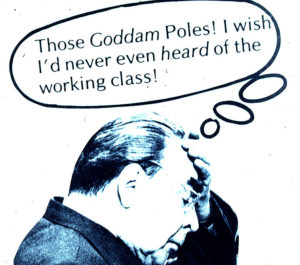 From Processed World #2, during the Solidarity movement’s height in Poland, 1981. The Situationists seem newly relevant, although for many radicals they never lost their acuity. In late February even the New York Times ran an op-ed by Robert Zaretsky called “Trump and the ‘Society of the Spectacle’, arguing for the relevance of Guy Debord’s seminal work:
With the presidency of Donald Trump, the Debordian analysis of modern life resonates more deeply and darkly than perhaps even its creator thought possible, anticipating, in so many ways, the frantic and fantastical, nihilistic and numbing nature of our newly installed government. In Debord’s notions of “unanswerable lies,” when “truth has almost everywhere ceased to exist or, at best, has been reduced to pure hypothesis,” and the “outlawing of history,” when knowledge of the past has been submerged under “the ceaseless circulation of information, always returning to the same list of trivialities,” we find keys to the rise of trutherism as well as Trumpism.
In his later work, “Comments on the Society of the Spectacle,” published almost 20 years after the original, Debord seemed to foresee the spectacular process that commenced on Jan. 20. “The spectacle proves its arguments,” he wrote, “simply by going round in circles: by coming back to the start, by repetition, by constant reaffirmation in the only space left where anything can be publicly affirmed …. Spectacular power can similarly deny whatever it likes, once or three times over, and change the subject, knowing full well there is no danger of any riposte.”
Actually I think it’s a curious problem to apply this analysis to Trump’s rise, implying as it does that the Spectacle has somehow risen anew on January 20. The point of the “Comments” in the late 1980s when it was written, was to argue that the Spectacle had become fully integrated between east and west, and that the ability of spectacular power to create its own circular logic depended on their being a basically univocal media universe. This was probably most visible in our impression of what life in the one-party state of the Soviet Union was like, but his argument, as I understood it, was that we too were living in a parallel state, where despite apparent “differences” and a so-called “free press” the information in our society too was that of a univocal perspective. I’ve often argued that we live in a one-party state with two factions. Sure the Republicans and Democrats disagree about various priorities, but when it comes to US empire, the rule of property, the dependence on militarism, oil, and autos, and the attendant shaping of the fabric of life to protect and extend the rule of billionaires and their corporate and governmental institutions, no real disagreement exists. In this sense, the true is a moment of the false, as Debord put it, and the deep truth of our lives is never acknowledged—that we are enslaved to a system that allows no real alternatives, and our “freedom” is always overwhelmingly contingent on our obedience, on our complicity in reproducing this world. The hyper-trivialization of mass entertainment, sports, and so-called politics has reinforced this logic for decades, whether the titular head of government was Bush, Clinton, or Obama.
Trump represents a kind of backwards challenge to the Spectacle. Of course his barely literate twitter feed has created a self-referential world unmoored from verifiable facts, a world that—incredibly—millions of people seem to believe in. Trump goes round and round, repeats his Big Lies incessantly and claims that anyone who says different is a the real liar. He and Bannon and the alt-right press are trying to establish hegemony for their version of the self-referential and circular Spectacle, but in so doing, they have underscored that there is not just one Spectacle at this juncture. What Trumpism has done is to crack apart the consensus view of the world. No longer is there a univocal media world full of self-referential platitudes about this being the best of all possible worlds, and anyway, the only one possible (don’t forget Margaret Thatcher’s T.I.N.A. admonition: There Is No Alternative!). Now we have the funhouse mirror Trump world that invites the anti-intellectual and resentful white America to hide in it to avoid the complicated realities of science, multicultural society, rising gender nonconformity, etc. The formal opposition is the previously self-satisfied world of the center-right mass media, the networks and CNN and big city newspapers, who are trying to come to grips with having their hold on power shattered. They are having to actually engage in adversarial reporting, a long lost art. For many of us it is kind of exhilarating to see journalism trying to crack the daily tidal wave of lies, distortions, and distractions. But the premise of this conflict is that Trump and all he represents is the outlier, and somehow the consensus view of reality, i.e., the Spectacle, must be reaffirmed and ultimately supplant the crude propagandists of Trumpism.
But the real wild card here is a resurgent civil society. From the women’s marches to the airport protests, the first weeks of Spectacular instability had millions of people moving into the public sphere directly, acting without waiting for mediation or instruction. Going forward, various organizations with diverse agendas are working to direct and harness the urgent and fertile insurgency percolating among millions of Americans whose expectations of representation are at an all-time low. Very quickly nonprofit organizations, tiny cadres of still-extant professional revolutionaries, and dozens of issue-oriented campaigns have rushed to get in front of this welling energy. A good time, perhaps, to look at the decades-long limits of radicalism between the 1970s and today.
Continue reading Gazing Ironically into the Cul-de-Sac of Radicalism
I am surprised and glad I went to the Women’s Marches in Oakland and San Francisco on Saturday, the day after Trump was inaugurated. The Friday night march in San Francisco was also worth going to, though more predictable and less inspiring than the surprisingly gigantic turnouts for the Women’s March, not just here in the Bay Area but across the U.S.
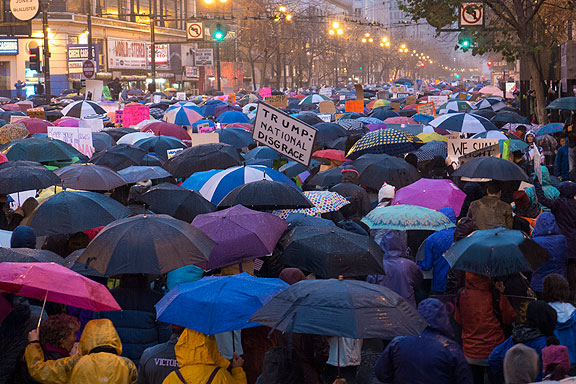 San Francisco at Jones and Market after 2 hours, the dense crowds continued… a friend counted over 220,000 standing not far from where I was, and he missed a bunch. In general I have grown to dislike the mass demonstration because of its utter predictability, its function as a zone of narcissistic self-congratulation, its exclusionary dynamics that often depend on a high tolerance for having speakers barking their slogans at you, or monitors scolding you for walking too far out of bounds, etc., or in any case an assumption of shared ideas and values where they barely exist. The fact that so many demos are organized by groups that I disdain or actively oppose only adds to the problem.
I’ve seen a few facebook friends going off in various ways about the Women’s Marches. Why didn’t these people protest earlier? Aren’t they all just a bunch of liberals and democrats? Why aren’t they more radical? Why didn’t they show up for all the other issues that smaller numbers of people have tried to mobilize around during the past decade? etc. etc. I’m sure there is plenty of truth to these complaints, but it really misses the point.
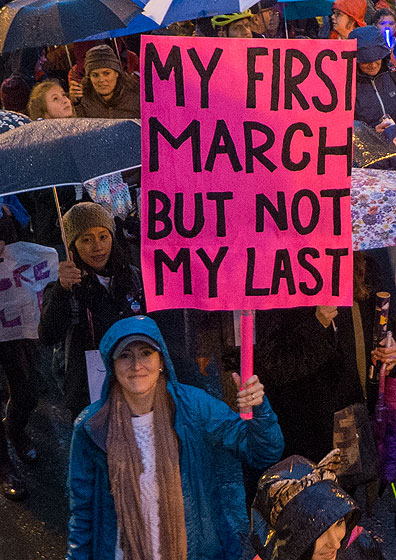 How many was this true of? A lot! For the huge swath of the country that has been resolutely unresponsive to radical critiques of this society, their world has shattered. The idea that we are basically a decent place with good people doing the best we can in a world where the neoliberal consensus has convinced most that there is no alternative to markets and meritocracy and capitalism has been impossible to shake with leftist chanting, anti-racist organizing, gender liberation struggles, etc. We might think the problem is with the folks who accept the anodyne platitudes of normalcy who we think should be more critical, more engaged, more thoughtful, and show more solidarity and compassion. Sure, I can see that. But it doesn’t matter. The left has grown smaller and more marginal over the past decades. Whatever we’ve been doing in whatever corner of the left we are in (gender, racial, labor, etc.) has not been working very well.
The Women’s March did not change all that. But to blame the people who turned out for all the failures of left organizing is just bitter and weird. I was really moved by the energy and earnestness of the tens of thousands of people (90,000+) I saw on the streets of Oakland during the morning and midday sunshine and then even more amazed by the over 200,000 people who doggedly stayed to march for hours from the Civic Center to the Ferry Building in the pouring rain. Sure, I know there’s a long way to go from one day of vocal repudiation and assertion to a developed movement that can impose its hegemony on government and the economy. But given the fear and panic and depression that so many people had fallen into since the election (or earlier), this was a huge morale booster for good people. To take the streets in such numbers is a powerful experience, even if the sign had it right: “I can’t believe we still have to protest this fucking shit!”
 uh.. yeah! from Oakland. I congratulate everyone who turned out, the wonderful creativity that went into the thousands of homemade, heartfelt signs, and I’m glad we opened a space for dialogue and critical thought. Now we can argue about how to fill that space, and to develop those muscles and skills in the time ahead. It’s going to take a mighty effort to wrest control of this society from the kleptocrats and militarists and ideological purity is a useless tool for this project. We all have to get better at talking to people we disagree with, and to accept the usefulness of argument and debate, and to learn to live with not being right, and not getting our way, and not always feeling “safe.”
And now a long gallery of images:
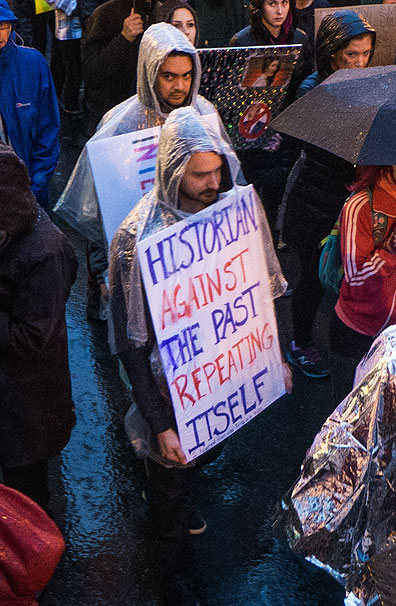 San Francisco 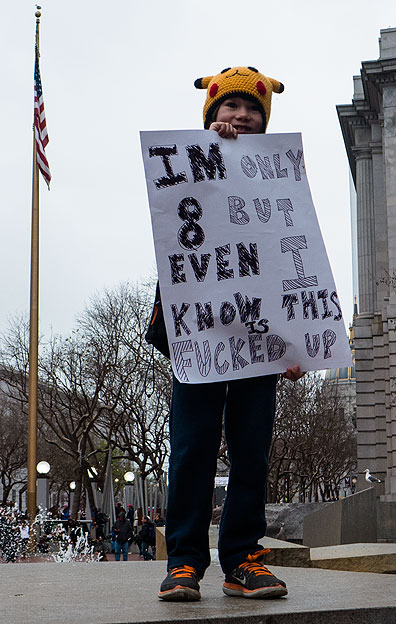 San Francisco 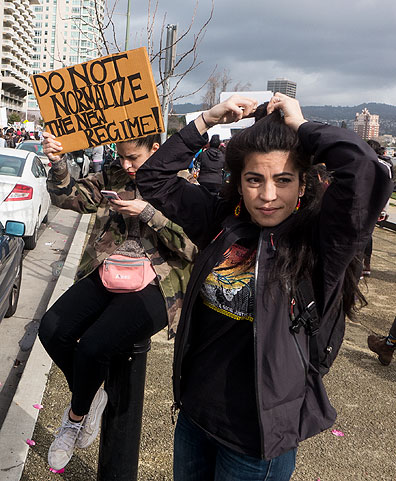 Oakland Continue reading Why I Loved the Women’s March, January 21, 2017
 These raccoons had their way in our backyard during our annual Posada on December 17… fearless critters! There haven’t been any recent attempts that I’m aware of, but I know it’s true. We had some very rambunctious raccoons rolling around our backyard during the Posada on December 17,and they were utterly unafraid of the dozen humans standing a few steps away. But they made no move to attack.
It’s actually a standing joke among my friends. I write and talk a lot about ecology and transforming urban life to harmonize with natural systems. I’m very concerned about climate change and probably pay more attention to the cascading bad news than most people I know. And yet I hate camping (dishwashing in the woods as far as I’m concerned). People and their pets (especially dogs) drive me crazy—I hate how people anthropomorphize their animals and then treat them like children. I eat meat with enthusiasm, and find proponents of animal rights and/or veganism too often some of the most pedantic, moralistic, and generally unhappy and unpleasant people I’ve met (with some exceptions, happily).
In spite of being an inveterate urbanite who feels safer sitting in a parking lot than next to a babbling brook buzzing with insects and birds, I think about nature and ecology a lot. Lately I’ve been reading a lot too, and I’ll be quoting from five different books during this post. It’s been a bit like taking a quick class in urban ecology, though the books covered here aren’t quite that focused. From the most philosophically minded, Imagining Extinction: The Cultural Meanings of Endangered Species (by Ursula K. Heise, University of Chicago Press: 2016), to the most down-to-city-earth Unseen City: The Majesty of Pigeons, The Discreet Charm of Snails & Other Wonders of the Urban Wilderness (by Nathanael Johnson, Rodale Press, New York: 2016), the books here help us take a big step back from the panicky urgency that arose in response to the election of Trump.
I understand that the Trump regime will be a wrecking ball to most of the environmental gains of the past half century. Moreover, developing a nuanced understanding of a healthy relationship between human life and nature will not only not gain traction, but whatever has been gained will likely be reversed now. But going into panic mode and rushing about without a strategy seems like a bad idea to me.
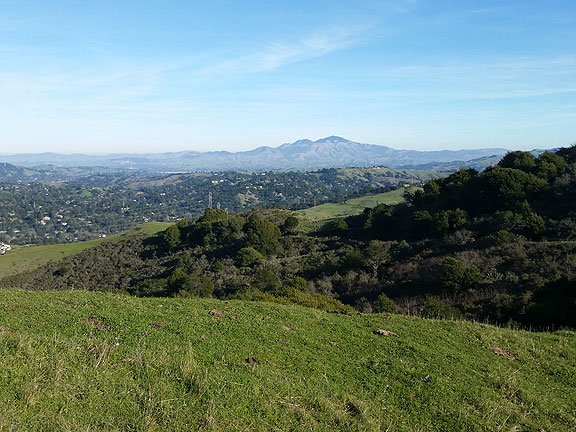 The view of Mt. Diablo from the top of the Sibley Volcano just southeast of the Caldecott Tunnel in the east bay hills. 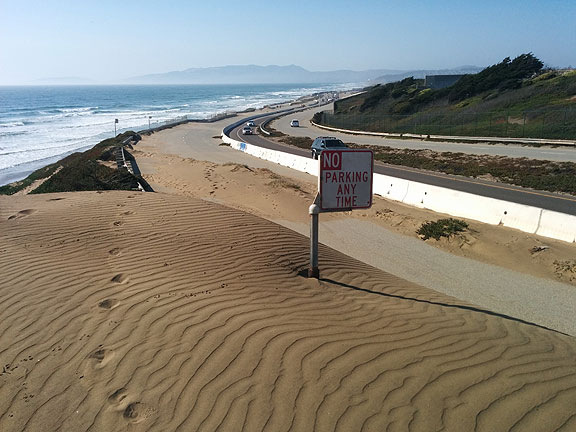 Nature having its way with infrastructure! I decided it’s a good time to think deeply about where we are and where we might go. The fraught politics of inequality built on centuries of racism, sexism and general fear and loathing of “others” is not something that doubling down on the smug self-satisfied rhetoric of coastal know-it-alls is going to adequately address. It’s hard to believe that anyone in their right mind could vote for an obvious liar and huckster like Trump. But when you pause for a moment it’s easy to see that Trump is not such a departure really, and that Americans have voted for frauds and charlatans as president almost as often as not. Something primal happens to voters, apparently, and given the chance to support a venal, hateful demagogue who promises the moon an awful lot of people say “give me the moon then,” realism be damned.
I am thankful for the time I had to read these smart books, which in addition to the two mentioned, also include Are We Smart Enough to Know How Smart Animals Are? (by Frans de Waal, W.W. Norton & Company, New York: 2016), Citizen Scientist: Searching for Heroes and Hope in an Age of Extinction (by Mary Ellen Hannibal, The Experiment LLC, New York: 2016), and Satellites in the High Country (by Jason Mark, Island Press: Washington DC 2015). An earlier book I read kept looping itself back into the conversation these books had in my head, which was Feral by George Monbiot that I briefly mentioned in an earlier post.
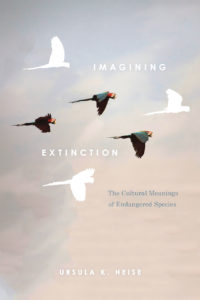
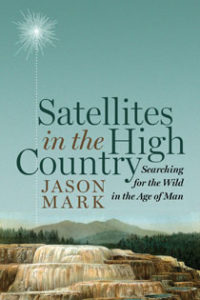 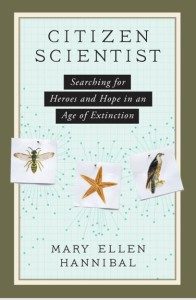 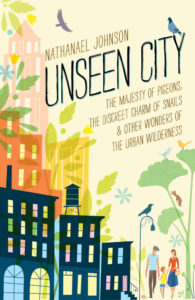  Monbiot argued in his book that we should restore apex predators into our environment to re-establish a sense of awe, fear, and excitement that we are lacking in modern life (imagine having to consider encountering a bear on the way to the corner store!). His book seeks to break with the dogmas of mainstream environmentalism, and to a great extent that is what is refreshing about all of these books too. Each of the writers in their own way is trying to rethink, reimagine, and propose a new approach to what has become an impossible cul-de-sac of environmental degradation, climate chaos, and rapidly accelerating extinction. All of the writers here have gone beyond the paradigms that beset radical environmental thinking only a generation ago, wherein humans were still largely outside of and the opposite of “nature.” All of them, in various ways, are trying to articulate new approaches to some kind of reconciliation, to finding a way that humans as natural beings can find an appropriate set of philosophical assumptions to shape new behaviors that in turn work with the logic of nature instead of being implacably against it. Monbiot argued in his book that we should restore apex predators into our environment to re-establish a sense of awe, fear, and excitement that we are lacking in modern life (imagine having to consider encountering a bear on the way to the corner store!). His book seeks to break with the dogmas of mainstream environmentalism, and to a great extent that is what is refreshing about all of these books too. Each of the writers in their own way is trying to rethink, reimagine, and propose a new approach to what has become an impossible cul-de-sac of environmental degradation, climate chaos, and rapidly accelerating extinction. All of the writers here have gone beyond the paradigms that beset radical environmental thinking only a generation ago, wherein humans were still largely outside of and the opposite of “nature.” All of them, in various ways, are trying to articulate new approaches to some kind of reconciliation, to finding a way that humans as natural beings can find an appropriate set of philosophical assumptions to shape new behaviors that in turn work with the logic of nature instead of being implacably against it.
Continue reading Nature is Trying to Kill Me!
|
|
















 Monbiot argued in his book that we should restore apex predators into our environment to re-establish a sense of awe, fear, and excitement that we are lacking in modern life (imagine having to consider encountering a bear on the way to the corner store!). His book seeks to break with the dogmas of mainstream environmentalism, and to a great extent that is what is refreshing about all of these books too. Each of the writers in their own way is trying to rethink, reimagine, and propose a new approach to what has become an impossible cul-de-sac of environmental degradation, climate chaos, and rapidly accelerating extinction. All of the writers here have gone beyond the paradigms that beset radical environmental thinking only a generation ago, wherein humans were still largely outside of and the opposite of “nature.” All of them, in various ways, are trying to articulate new approaches to some kind of reconciliation, to finding a way that humans as natural beings can find an appropriate set of philosophical assumptions to shape new behaviors that in turn work with the logic of nature instead of being implacably against it.
Monbiot argued in his book that we should restore apex predators into our environment to re-establish a sense of awe, fear, and excitement that we are lacking in modern life (imagine having to consider encountering a bear on the way to the corner store!). His book seeks to break with the dogmas of mainstream environmentalism, and to a great extent that is what is refreshing about all of these books too. Each of the writers in their own way is trying to rethink, reimagine, and propose a new approach to what has become an impossible cul-de-sac of environmental degradation, climate chaos, and rapidly accelerating extinction. All of the writers here have gone beyond the paradigms that beset radical environmental thinking only a generation ago, wherein humans were still largely outside of and the opposite of “nature.” All of them, in various ways, are trying to articulate new approaches to some kind of reconciliation, to finding a way that humans as natural beings can find an appropriate set of philosophical assumptions to shape new behaviors that in turn work with the logic of nature instead of being implacably against it.









